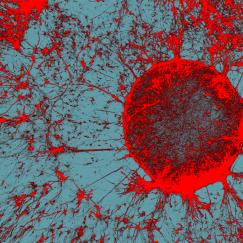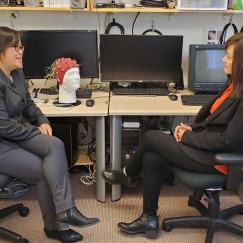Insightful genetics, innovative microscopy
Professor Elly Nedivi’s lab, which started at MIT in 1998, has discovered genes underlying plasticity – the capability of the central nervous system to remodel its circuits in response to experience and activity. Plasticity is always happening, Nedivi said, but it is most prominent during development. Many capabilities such as language, vision, or even socialization can only fully develop within a “critical period” of youth when brain circuitry is molded by the environment.
In plasticity, the connections between neurons, or synapses, get stronger or weaker. Nedivi wanted to know how. She set out to find “candidate plasticity genes.” Nedivi’s screens led to hundreds of genes that are responsive to neural activity, but she honed in on ones whose proteins are expressed specifically at the synapse, in response to natural environmental stimuli, and that associate with cellular remodeling. She’s focused on two that had not been studied before: CPG2 and CPG15.
“We’ve basically followed them where they took us,” Nedivi said.
She’s shown that CPG15 encodes an extracellular signaling molecule that promotes synapse stability and neural growth. CPG2 expression regulates receptors at the synapses of glutamate-producing neurons. CPG2 also happens to be the product of a gene that is number two on the list of those most strongly associated with risk for bipolar disorder. Nedivi didn’t set out to study bipolar disorder, but this is an example of how curiosity about fundamental aspects of development can lead to discoveries relevant to human health. Now her lab is working to understand the functional significance of human mutations in the gene and their relation to bipolar disorder.
Nedivi’s studies have also contributed to understanding plasticity in adults. Synapses are constantly remodeling, but while it’s not hard to see dramatic synaptic changes during development, changes are more subtle in the adult brain. Nedivi’s desire to observe synapse remodeling in the context of the living brain, has compelled her to develop new tools. In collaboration with MIT mechanical engineer and optics expert Peter So, Nedivi has devised ways to image whole neurons at synaptic resolution, and to add new colors to two-photon imaging to allow simultaneous and distinct imaging of inhibitory and excitatory synapses in real time in live mice. More recently they have devised a way to make imaging faster so that more ephemeral phenomena do not go unnoticed.
From ferrets to clinical trials
Mriganka Sur, the Paul and Lilah Newton Professor, has spent more than 30 years at MIT studying the basic rules of plasticity. Soon after he arrived, he made a particularly powerful demonstration. In developing ferrets, Sur and his colleagues disconnected the hearing pathways to auditory centers, including the auditory cortex. Astonishingly the ferrets did not leave that cortex fallow for lack of stimulation. Instead they innervated the auditory cortex with inputs from the eyes, creating a supplementary visual cortex, and repurposing unused neural resources to go where the sensory action was. ‘Rewired’ ferrets could use their auditory cortex to see.
Since then, he’s continued to study the rules and mechanisms of plasticity. His lab discovered hundreds of genes and microRNAs used by the visual cortex to change synapses.. All synapses change in response to experience: some, driven by specific molecules, strengthen, whereas others, driven by different molecules, weaken. Together, these changes rewire circuits but keep overall activity levels similar.
In one line of research, his lab discovered in 2009 that expression of MeCP2 changes considerably amid plasticity, participating in a synapse-enhancing pathway with a protein called IGF1. Lacking MeCP2 is a cause of the neurodevelopmental disorder Rett Syndrome. Sur’s lab found that mice lacking MeCP2 had increased plasticity in visual cortex. When they gave MeCP2 knock-out mice injections of IGF1, they restored plasticity to normal levels, opening up a therapeutic possibility for Rett. Now the approach is being tested in clinical trials.
This spring Sur’s lab also published research showing that a different form of plasticity in the visual cortex depends on a pathway involving the gene MVP, which is one of the genes lost in 16p11.2 deletion autism..
Theory begets strategy
Inspired by Hubel and Wiesel’s 1963 demonstration that a kitten temporarily deprived of vision in an eye during a critical period lost vision in that eye forever, Bear set out to understand plasticity in vision and learning and memory.
At Brown University in the 1980s and ‘90s he collaborated with physicist Leon Cooper, who had co-developed a mathematical theory of plasticity. An important prediction was that sometimes active neural connections called synapses should weaken, a process called long-term depression. Bear’s lab showed LTD was real.
“We found a protocol that elicited LTD,” Bear said. “That got the whole ball rolling on LTD and now there are 1,000s of papers.”
LTD is enormously consequential in development, Bear said. Young brains form way too many synapses and then edit, or “prune” them away with maturity. One scientist has even calculated that the developing monkey visual cortex loses 5,000 synapses per second during adolescence, Bear said.
In the hippocampus, Bear showed that one form of LTD requires rapid protein synthesis at the synapse. The finding led to a focus on a protein called FMRP, which stands for Fragile X mental retardation protein because its loss causes the intellectual disability disorder Fragile X syndrome.
Bear joined Picower in 2003. His research here showed that FMRP acted as a brake on LTD by regulating protein synthesis. In 2007 his lab showed they could ameliorate Fragile X in mice by inhibiting the receptor that stimulates protein synthesis and triggers LTD, called a metabotropic glutamate receptor. Bear subsequently formed a company to test the strategy in clinical trials.
All along, Bear lab’s retained its interest in vision. In 2016, years of research on visual plasticity resulted in a radical idea for treating amblyopia, a common form of monocular vision loss in children. In animals they found that temporarily disabling both eyes with a blowfish toxin essentially “reboots” plasticity in both eyes, allowing the eye with lost vision to rebuild sight, another potential therapy born from underlying theory.
Discovery and diversity
Neural development helped to launch Picower Professor Li-Huei Tsai’s career in brain science, though she didn’t necessarily expect that. As a cancer researcher at Harvard in the early ‘90s Tsai identified a particular enzyme, Cdk5, that turned out to only be active in the nervous system.
Tsai’s studies of Cdk5 revealed that it was crucial for neural development, in particular the migration of newly born neurons to the cortex. Without Cdk5, the brain wouldn’t form its characteristic lamination, leading to abnormal neural circuit formation and epileptic activity.
In later work, Tsai discovered that when a protein called p35 that regulates Cdk5 breaks down into p25, the ensuing overactivity of Cdk5 leads to neurodegeneration in the adult brain, a crucial insight into Alzheimer’s disease. Her lab invented a powerful model of Alzheimer’s, the p25 mouse, to inform research.
Tsai, who arrived at MIT in 2006, still studies development in diverse ways. In one program, her lab is investigating Down syndrome by using induced stem cells from patients to grow new “minibrain” organoids. In the lab, her team can watch how the model brains develop differently from ones without the chromosomal abnormality.
Tsai’s lab also houses the work of Picower Clinical Research Fellow Dr. Ravi Raju, who spoke at the Institute's May 9 symposium on early life stress. He is asking how modeling poverty-like early life stress in mice may cause gene expression to differ. He has found that mice who make specific “epigenetic” changes are better able to resist anxiety than mice who don’t.
Development is a process, and often one never knows exactly how it will turn out. The same could be said for studies of brain development.






